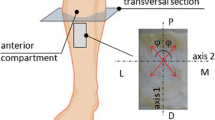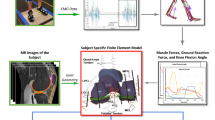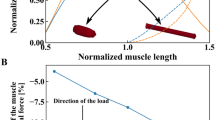Abstract
The focus of this work is the numerical modeling of the anterior compartment of the human leg with particular attention to crural fascia. Interaction phenomena between fascia and muscles are of clinical interest to explain some pathologies, as the compartment syndrome. A first step to enhance knowledge on this topic consists in the investigation of fascia biomechanical role and its interaction with muscles in physiological conditions. A three-dimensional finite element model of the anterior compartment is developed based on anatomical data, detailing the structural conformation of crural fascia, composed of three layers, and modeling the muscles as a unique structure. Different constitutive models are implemented to describe the mechanical response of tissues. Crural fascia is modeled as a hyperelastic fiber-reinforced material, while muscle tissue via a three-element Hill’s model. The numerical analysis of isotonic contraction of muscles is performed, allowing the evaluation of pressure induced within muscles and consequent stress and strain fields arising on the crural fascia. Numerical results are compared with experimental measurements of the compartment radial deformation and intracompartmental pressure during concentric contraction, to validate the model. The numerical model provides a suitable description of muscles contraction of the anterior compartment and the consequent mechanical interaction with the crural fascia.







Similar content being viewed by others
References
Arnold EM, Ward S, Lieber RL, Delp SL (2009) A model of the lower limb for analysis of human movement. Ann Biomed Eng. doi:10.1007/s10439-009-9852-5
Benjamin M (2009) The fascia of the limbs and back—a review. J Anat 214:1–18. doi:10.1111/j.1469-7580.2008.01011.x
Chaudhry H, Bikiet B, Roman M, Stecco A, Findley T (2013) Squeeze film lubrication for non-Newtonian fluids with application to manual medicine. Biorheology 50:191–202. doi:10.3233/BIR-130631
Cowin SC (2000) How is a tissue built? J Biomech Eng 122:553–569. doi:10.1115/1.1324665
Dahl M, Hansen P, Stål P, Edmundsson D, Magnusson SP (2011) Stiffness and thickness of fascia do not explain Chronic Exertional Compartment Syndrome. Clin Orthop Relat Res 469:3495–3500. doi:10.1007/s11999-011-2073-x
Dubuis L, Avril S, Debayle J, Badel P (2012) Identification of the material parameters of soft tissues in the compressed leg. Comput Methods Biomech Biomed Eng 15:3–11. doi:10.1080/10255842.2011.560666
Ehret A, Böl M, Itskiv M (2011) A continuum constitutive model for the active behaviour of skeletal muscle. J Mech Phys Solids 59:625–636. doi:10.1016/j.jmps.2010.12.008
French EZ, Price WH (1962) Anterior tibial pain. Br Med J 2:1290–1296
Friden J, Sfakianos PN, Hargens AR (1985) Muscle soreness and intramuscular fluid pressure: comparison between eccentric and concentric load. J Appl Physiol 61:2175–2179
Gershuni DH, Gosink BB, Hargens AR, Gould RN, Forsythe JR, Mubarak SJ, Akeson WH (2011) Ultrasound evaluation of the anterior musculofascial compartment of the leg following exercise. Clin Orthop Relat Res 10:59–65
Hargens AR, Schmidt DA, Evans KL, Gonsalves MR, Cologne JB, Garfin SR, Mubarak SJ (1981) Quantitation of skeletal-muscle necrosis in a model compartment syndrome. J Bone Joint Surg Br 63:631–636
Hurschler C, Vanderby R, Martinez DA, Vailas AC, Turnipseed WD (1994) Mechanical and biomechanical analyses of tibial compartment fascia in chronic compartment syndrome. Ann Biomed Eng 22:272–279
Joahansson T, Meier P, Blickhan R (2000) A finite-element model for the mechanical analysis of skeletal muscle. J Theor Biol 206:131–149. doi:10.1006/jtbi.2000.2109
Leonard J (2013) Importance of considering myofascial force transmission in musculoskeletal surgeries. J Surg Acad 3:1–3
Maas H, Sandercock TG (2010) Force transmission between synergistic skeletal muscles through connective tissue linkages. J Biomed Biotechnol. doi:10.1155/2010/575672
Mijailovich SM, Stojanovic B, Ko Liang A, Wedeen VJ, Gilber RJ (2010) Derivation of a finite-element model of lingual deformation swallowing from the mechanics of mesoscale myofiber tracts obtained by MRI. J Appl Physiol 109:1500–1514. doi:10.1152/japplphysiol.00493.2010
Mubarak SJ, Owen CA, Hargens AR, Garetto LP, Akeson WH (1978) Acute compartment syndromes: diagnosis and treatment with the aid of the wick catheter. J Bone Joint Surg Br 60:1901–1905
Pavan PG, Pachera P, Natali AN (2015) Numerical modelling of crural fascia mechanical interaction with muscular compartments. Proc Inst Mech Eng H 229:395–402. doi:10.1177/0954411915584963
Roman M, Chaudhry H, Bukiet B, Stecco A, Findley TW (2013) Mathematical analysis of the flow of hyaluronic acid around fascia during manual therapy motions. J Am Osteopath Assoc 113:600–610. doi:10.7556/jaoa.2013.021
Stecco C, Porzionato A, Lancerotto L, Stecco A, Macchi V, Day JA, De Caro R (2008) Histological study of the deep fascia of the limbs. J Bodyw Mov Ther 12:225–230. doi:10.1016/j.jbmt.2008.04.041
Stecco C, Pavan PG, Porzionato A, Macchi V, Lancerotto L, Carniel EL, Natali AN, De Caro R (2009) Mechanics of crural fascia: from anatomy to costitutive modelling. Surg Radiol Anat 31:523–529. doi:10.1007/s00276-009-0474-2
Stecco C, Pavan PG, Pachera P, De Caro R, Natali AN (2014) Investigation of the mechanical properties of the human crural fascia and their possible clinical implications. Surg Radiol Anat 36:25–32. doi:10.1007/s00276-013-1152-y
Tang C, Zhang G, Tsui CP (2009) A 3D skeletal muscle model coupled with active contraction of muscle fibres and hyperelastic behavior. J Biomech 42:865–872. doi:10.1016/j.jbiomech.2009.01.021
Turnipseed WD, Hurschler C, Vanderby R (1995) The effects of elevated compartment pressure on tibial arteriovenous flow and relationship of mechanical and biomechanical characteristics of fascia to genesis of chronic anterior compartment syndrome. J Vasc Surg 2:810–817
Acknowledgements
The authors wish to thank the staff of the Laboratory of Design Tools and Methods in Industrial Engineering of the University of Padova for their technical support. The support of Carla Stecco (Department of Molecular Medicine, University of Padova) in obtaining muscle echography and images of crural fascia under polarized light is also acknowledged.
Author information
Authors and Affiliations
Corresponding author
Ethics declarations
Conflict of interest
The authors disclose to have no financial and personal relationships with other people or organizations that could inappropriately influence (bias) their work.
Rights and permissions
About this article
Cite this article
Pavan, P.G., Pachera, P., Forestiero, A. et al. Investigation of interaction phenomena between crural fascia and muscles by using a three-dimensional numerical model. Med Biol Eng Comput 55, 1683–1691 (2017). https://doi.org/10.1007/s11517-017-1615-0
Received:
Accepted:
Published:
Issue Date:
DOI: https://doi.org/10.1007/s11517-017-1615-0




